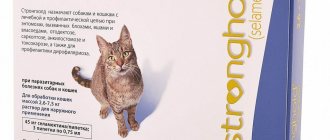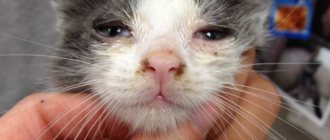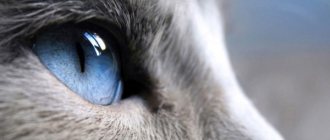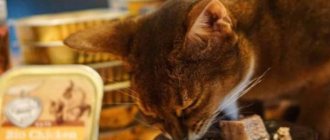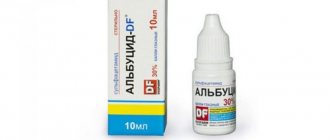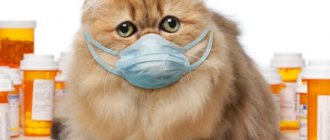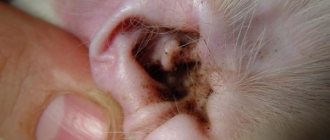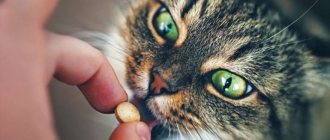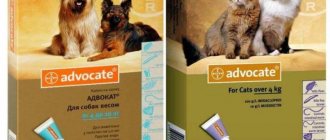For cats, eyes are one of the most important organs with which they navigate the world around them.
The animal has a high probability of contracting some disease or injuring the cornea.
- A pet can easily get mechanical damage when climbing trees while walking or establishing territorial positions with other cats.
- Infectious disease - if the animal comes into contact with yard cats. Also, like a person, it is possible for him to have an allergic reaction to household chemicals or some food products.
But this does not mean that you should lock up your pet and not let it out anywhere.
Description and principle of operation
Cats often have eye problems: due to mechanical injuries, infection due to contact with street animals. Drops are used to treat and prevent cat eye diseases:
- Antiseptic. Used for purulent processes of bacterial origin. Destroy pathogenic pathogens, restoring physiological balance in eye fluids.
- Moisturizing. Softens the cornea, eliminates dryness, and reduces redness.
- Antihistamines. Effectively relieve allergic symptoms, reduce itching, swelling, and redness. Helps reduce the manifestation of allergenic symptoms.
Antiseptic
Drops of this group are used for eye diseases caused by bacteria or fungus. They are obtained on the basis of substances of chemical origin that have a disinfecting effect. Antiseptics are effective against most pathogens of conjunctivitis and blepharitis; the resistance of microorganisms to such agents is very low. The most effective and safe in veterinary medicine are:
- Lacrican.
The active ingredients are antiseptic polysept, anesthesin and menthol. These eye drops have an antimicrobial and anesthetic effect and are indicated for acute and chronic infectious conjunctivitis and blepharitis in cats. The price of a 10 ml bottle is about 100 rubles. - Lakrimin aseptic.
Active ingredients: chloramphenicol and sodium sulfosalicylate. Used for the treatment of catarrhal, purulent, follicular blepharitis and conjunctivitis, as well as for the development of postoperative complications. The packaging of the drug (10 ml plastic bottle) costs 250 rubles. - Barrier.
Ophthalmic drug based on the antiseptic decamethoxin. It has excellent anti-inflammatory and antiallergic properties, is active against gram-positive and gram-negative microorganisms. Packaging: 10 ml bottles with a dropper cap, price - 35-40 rubles. - Ophthalmosan.
A complex preparation that includes: antiseptic chlorhexidine bigluconate, extracts of medicinal herbs (chamomile, calendula, eyebright), succinic acid, which has a local immunostimulating effect.
For cats, Oftalmosan drops are used as a means of preventing and treating eye diseases of bacterial etiology, and are also used for hygienic treatment of eyes for tearing. The price of a 15 ml bottle is 250 rubles.
Diamond eyes. The active ingredients are the antiseptic chlorhexidine bigluconate and the cell repair (restoration) stimulator taurine. The drug has good antiseptic, anti-inflammatory, anti-edematous and regenerating effects. Packaging price (plastic pipette bottle with a capacity of 10 ml) - 200 rubles.
Can Tobrex be given to cats?
Today, for the treatment of animals, there is an extensive group of highly specialized drugs that are considered veterinary drugs. “Tobrex” is not one of these drugs, since its main goal is to eliminate all kinds of infectious pathologies caused by bacteria specific to the human body. However, these drops are widely used to treat animals.
This is due to the fact that they have a wide spectrum of action against several groups of bacteria at once, and in most cases do not cause any side effects. In addition, Tobrex does not cause irritation to the mucous membrane or tissues of the eyeball, which makes it an absolutely safe product.
Did you know? Veterinary medicine is included in the list of the most ancient medical disciplines. The first mentions of animal diseases and methods of eliminating them are found in ancient Egyptian writings dating back to the 2nd millennium BC. e.
List of Effective Eye Ointments for Cats
- When are eye ointments prescribed?
- How to choose a good drug?
Choosing a good eye ointment for a cat is considered a very important undertaking, since in some cases the pet’s vision depends on it.
This is especially true when an animal requires rehabilitation therapy after surgery on one or two organs of vision.
We present to you a list of the most commonly prescribed drugs that help relieve inflammation and have an antibacterial effect.
When are eye ointments prescribed?
In most cases, cats are prescribed drops that are combined with ointments in the following cases:
- corneal injuries (scratches, punctures);
- injuries of the inner eyelid (scratches, ulcers);
- inflammatory process (redness, swelling);
- complications of viral infections (chlamydia, herpesvirus, calicivirus);
- uveitis;
- keratitis;
- all types of conjunctivitis.
Antibiotic eye ointment is prescribed for cats whose conjunctivitis is caused by an infectious disease.
How to choose a good drug?
In cases with the eyes, all medications must be strictly prescribed by an ophthalmologist based on the examination and diagnosis. Only in extreme cases (the animal cannot be taken to a veterinary clinic, but assistance needs to be provided), the remedy is selected based on the clinical picture. For damage to the organs of vision, the following drugs are most often prescribed:
Tetracycline. Made on the basis of the active ingredient Tetracycline, which is considered a broad-spectrum antibiotic. It is this fact that makes this eye ointment universal for cats of all breeds and ages.
Widely used in veterinary practice in the treatment of inflammatory processes caused by corneal injuries and entropion. It is considered a powerful antibacterial agent for the treatment of uveitis, keratitis and many types of conjunctivitis.
Eliminate the possibility that the pet may rub its eye with its paw, thereby preventing the ointment from being evenly distributed throughout the conjunctiva and causing even greater damage to itself due to mechanical action. This can be done using a special medical cap, which is placed around the neck and the animal cannot reach its muzzle with its paws.
Phloxal. Another eye ointment for cats with an antimicrobial antibiotic. I made it based on ofloxacin. Manufactured in Germany by Dr. Mann. Most often prescribed to kittens with chlamydial infection.
Also excellent as an antibacterial drug for corneal ulcers, uveitis and keratoconjunctivitis sicca. Floxal is very often prescribed as a replacement for tetracycline ointment if the pet has side effects from it. The number of treatments per day is calculated by the doctor, based on the severity of the lesion.
In some cases, one affected organ (corneal ulcer) is treated. To do this, the lower eyelid is carefully pulled back and a thin layer of ointment is placed in the conjunctival sac. Then the eyelid returns to its usual place. You can gently massage the animal's eye to distribute the medication evenly.
Do not allow your pet to rub its eyes after treatment so that the drug has time to dissolve and enter the bloodstream.
Korneregel. Another eye ointment for cats from the same German brand, Dr. Mann. Made from the active ingredient dexpanthenol. Korneregel can rightfully be called the most frequently prescribed drug in ophthalmology.
This can easily be explained by its versatility, thanks to which it can be used not only for corneal damage, but also for fungal and bacterial infections. Korneregel has also proven itself in the treatment of the conjunctiva after varying degrees of burns. For corneal erosions, it is recommended to use the product 2-3 times a day.
Korneregel is often combined with other medications, but the manufacturer strongly recommends maintaining a 15-minute interval between using Korneregel and another drug.
Erythromycin ointment. Made on the basis of the antibiotic of the same name, which has proven itself as an antimicrobial and anti-inflammatory agent. Most often, erythromycin ointment is prescribed together with tetracycline or cornegel.
It is successfully used in the treatment of many types of conjunctivitis and blepharitis. Method of application: apply a small amount of ointment under the eyelid, which is evenly distributed over the entire surface of the conjunctiva by rotating a finger across the eyelid.
Some of the eye ointments we described are considered essential products that should be present in the first aid kit of every cat or dog owner.
Indications for use
Eye diseases in cats are invariably accompanied by pain and unpleasant symptoms such as pathological discharge and blurred vision. Even banal redness, if left untreated, can turn into swelling and puffiness.
With the help of various drops you can get rid of the following manifestations:
- infectious lesion;
- conjunctivitis;
- keratitis;
- blepharitis;
- entry of foreign bodies;
- traumatic injuries;
- allergic manifestations;
- chlamydia, mycoplasmosis;
- glaucoma;
- clouding of the lens, cornea.
Tsiprolet
The basis of this effective remedy is the substance ciprofloxacin. It has the following properties:
- destroys bacteria;
- stops inflammatory processes;
- fights chlamydia;
- Pseudomonas aeruginosa;
- staphylococcus.
For a cat, it will be enough to inject one drop of the drug into the affected eye four times a day for 14 days.
Moreover, if there is also discharge of pus or mucus, Tsiprolet is also used to wash the eyes. The medicine is applied in a volume of several drops onto a gauze pad.
Possibility of using eye drops
Eye drops for cats are used in the treatment of conjunctivitis, blepharitis or keratitis. Veterinarians prescribe drops to animals after eye surgery to prevent complications, and when the eyes become infected after injury.
The drug has an antimicrobial effect and is used to treat many infections, as well as as a prophylactic against ophthalmic diseases. The medicine acts quickly, it can be used to cure not only the eyes: in some cases it is prescribed as drops in the animal’s nose.
Drops against teary eyes on the street
The appearance of tears in frosty or hot weather is not always regarded as a sign of illness. More often it is a protective reaction of the body to external stimuli. You should be concerned when a sign appears that accompanies itching, redness and other unpleasant symptoms.
Recommended drops depending on the cause of tearing:
- For increased dryness. Medicines such as Vizin, Lakrisin, Vidisik will help protect the mucous membrane.
- If an allergic reaction develops, antihistamines are prescribed. For example, Lakrisin, Vidisik, Vizin.
- In case of increased sensitivity to external stimuli, medications are used that constrict blood vessels. These include Naphthyzin and Vizin.
Rules of application
Eye diseases in cats are quite common. It is important not only to contact a specialist in a timely manner, but also to use the prescribed medication correctly:
- The cat is placed on the lap with its back to the owner.
- The animal should not see containers, pipettes and cotton pads.
- The eyes and fur around the eyes are washed with clean boiled water.
- For washing, you can use an infusion of chamomile or calendula.
- After clearing the discharge and pus, the lower eyelid is retracted and the medicine is administered.
- For several minutes, until the cat calms down, hold it in your arms, not allowing it to scratch its eyes.
Something else interesting: Deworming tablets for cats
The procedure is carried out as often as required according to the instructions.
What solution should you wash your eyes with?
It is important not only to know how to properly clean a cat’s eyeball of pus, but also what solution is allowed to do this. If you notice inflamed eyes, the right decision would be to contact a veterinarian
He will advise you on what solution you can use to clean your cat’s eyes. The veterinarian will take a swab from the conjunctiva for analysis and accurately determine the cause of inflammation and pus formation. Usually he prescribes:
- Furacilin solution has an excellent antibacterial effect. You can buy a ready-made solution, or you can prepare it yourself. Take two tablets of furatsilin per glass of warm boiled water, crush to a powder, bring to complete dissolution by constant stirring. Before dripping into the cat's eyeball, you need to strain it through double gauze so that the medication particles do not damage the mucous membrane.
- A solution of boric acid is prepared as follows: take one teaspoon of boric acid per glass of boiled water and stir thoroughly until completely dissolved.
- A saline solution is good for removing foreign particles and dirt.
- Diamond Eyes drops have a good effect.
If the kitten shows pus that irritates the pet, the veterinarian will often prescribe the following medications:
- Tetracycline eye ointment.
- Hydrocortisone eye ointment.
- Levomycetin powder.
- Tsiprovet.
- Iris.
It is not recommended to use ointment with antibiotics and hormonal agents without a veterinarian's prescription.
Folk remedies
If there are no medications and you need urgent help, then you can use home remedies:
- Medical chamomile decoction. To prepare the decoction, take 2 teaspoons of the mixture, purchased at a pharmacy, in 60 milliliters of boiling water, leave for 5 minutes. Before use, strain through double gauze.
- The tea solution not only cleanses of foreign particles, but also acts as an antiseptic. You cannot use freshly brewed tea. Yesterday's tea leaves work well, but it is strictly forbidden to use two-day-old tea leaves, because bacteria begin to multiply in it.
- A solution of potassium permanganate is used to clean the eyeball. The medicinal solution should have a slightly pinkish color without the presence of undissolved crystals. Otherwise, it threatens to burn the mucous membrane.
Most kittens have problems with their eyes. With the right approach, the owner can deal with this problem quite easily; the main rule is not to delay cleaning the eyeballs. If eye inflammation does not go away, then it is advisable to consult a veterinarian.
Features of treatment
Instructions for use of Tobrex contain all recommendations for proper instillation of the product. Tobrex drops are prescribed for external use in local areas. The drug is instilled into the conjunctival sac of the diseased visual organ. In case of mild inflammation or moderate disease, use no more than two drops every four hours. In severe cases of the disease, the solution is instilled every 30-60 minutes.
Exceeding the dosage leads to swelling of the eyelids, a burning sensation and redness of the conjunctiva. To eliminate the symptoms of overdose, symptomatic therapy is used.
Description of the most effective drops
After the veterinarian determines the nature of the disease, he prescribes adequate treatment in accordance with the severity of its course, the condition of the animal, and its individual predisposition to various medicinal substances.
In particular, antibiotics are most often prescribed for conjunctivitis.
Such medications are used up to 6 times a day, a few drops, under the eyelid. The course of antibiotics is always at least seven days. If necessary, the effect of therapy is increased with the help of Tetracycline ointment.
How to put drops in a cat's eyes
Medicines are instilled directly into the animal's eyes. First of all, try to calm the cat down. Place her on your lap, pet her, talk quietly and calmly. If the animal behaves nervously and aggressively, you can carefully wrap it in a towel.
If there is purulent or mucous discharge on the eyes, clean them with a cotton pad soaked in lotion.
In some cases, preliminary purification is carried out using the medicine itself. The admissibility of this action is indicated in the instructions.
Then place one palm on the cat's head, lift it up and use your fingers to open the eyelid. Place one drop and allow your pet to close the eye to distribute the product. Another way is to squeeze a few drops of the drug into the corner of a closed eye, then open the cat’s eyelids.
Repeat the procedure if necessary. At the end, praise your cat and give her a rewarding treat.
The break between instilling different types of drops should be at least 20 minutes.
Hygienic lotions are not instilled, but applied to a cotton pad or napkin, after which they wipe the cat’s eyes from the inner corner to the outer.
Please note that a number of hygiene products can cause staining or discoloration of the fur around the eyes, which is especially undesirable for show animals.
In addition to special products, you can use strong black tea or saline solution to clean your eyes.
Chamomile decoction is not recommended. One day, my relatives’ Persian cat began to “cry” more than usual, and they tried to solve the problem with chamomile - but after that, in addition to profuse lacrimation, baldness of the area around the eyes was added. The relatives were frightened, suspecting a skin disease, but, as the veterinarian explained, the cause was precisely the decoction - the substances contained in chamomile, when applied externally, lead to hair loss.
Most cats have their eyes cleaned once a day in the morning. For breeds with a natural tendency to tear, such as Persians or Britons, this procedure may be required more often, up to 2-3 times a day.
Inflammatory processes of the eyes in cats and their signs
Cat owners can easily detect eye disease in their pet - each disease has its own symptoms, but there are common signs that indicate the presence of problems:
- the upper or lower eyelid takes on an uncharacteristic shade;
- swelling appears;
- the cat squints, blinks a lot, tears flow;
- discharge of pus or mucus;
- the shade and size of the cornea or pupil change.
The most common eye diseases in cats:
- conjunctivitis is an inflammation of the mucous membrane, veterinarians distinguish three types of the disease: catarrhal - occurs due to injuries to the eyelids or a foreign body that has entered the eye, in this case the animal begins to have profuse lacrimation, the eyelids look swollen;
- follicular - there is an increase in the lymph nodes of the third eyelid, the disease progresses when the cat is in unsanitary conditions;
- purulent - the infection affects the mucous membrane of the eyelids and eyes, swelling and discharge of pus are visually noted.
- inversion and entropion of the eyelids - appear due to untreated conjunctivitis or foreign objects entering the eye, cats begin to be afraid of light, and if not treated in a timely manner, a corneal ulcer may develop;
- keratitis is a corneal inflammation that appears due to a foreign body entering the eye or injury; in cats, the eyelids turn red, the shade of the cornea changes, tears flow profusely, there are three types of disease: ulcerative;
Causes
There can be many possible reasons for the occurrence of conjunctivitis in cats, here are the main ones:
Viruses, bacteria and fungi
Probably the most common reason. Eyes are not only a mirror of the soul, but also an “indicator” of health. They almost always give out if you are not feeling well. Therefore, conjunctivitis develops in almost all viral or bacterial diseases. Fungal disease is more complicated. The culprits “settle” on the conjunctiva, seriously affecting it. Fungi are much more difficult to get rid of than viruses and bacteria.
Allergy
And this reason is recorded quite often. In both humans and animals, an allergic reaction manifests itself with similar symptoms. And this is not only a runny nose, sneezing, itching, sore throat or ear, but also lacrimation. The conjunctiva turns red, swells, and itches. Tears just flow. Allergic conjunctivitis in cats goes away only after you help your pet get rid of allergies. To do this, you will have to detect the allergen and eliminate it forever, and treat the pet.
Mechanical damage
Any wound is a gateway to infection. And in order to somehow protect itself, the conjunctiva (more precisely, the lacrimal glands) produce a large number of tears. This reduces the “concentration” of microorganisms, but does not completely get rid of them. Sooner or later, some microbe will get to the wound. And here you go. Cats have developed conjunctivitis. Any eye injury is very dangerous
It doesn’t matter whether the eyelid or the eyeball is damaged. There is a risk of losing vision in both cases
Chemical substances
In this case, catarrhal conjunctivitis in cats develops not only due to the contact of chemical vapors with the mucous membrane. Much worse are burns to the mucous membrane. After all, they can lead to blindness of the animal, because you need to act instantly.
Pets are very curious. And as soon as you leave an open can of paint, solvent or household chemicals, a four-legged mustache is right there, sniffing everything, sticking its nose everywhere. And if this inquisitive person gets to the washing powder, then the chance of “earning” conjunctivitis increases.
There is both chemicals and tiny grains that will be a foreign body in the eye and can scratch the conjunctiva.
Irradiation
And ultraviolet, and radioactive, and x-rays.
All this negatively affects the animal. Keep away from such radiation sources. You shouldn't be surprised that someone has similar ones at home. Those who keep turtles or other reptiles equip the terrarium with ultraviolet lamps, which are dangerous for the eyes (more precisely, for the retina) of animals and children (and they will not bring any benefit to adults either). In addition, many girls buy themselves ultraviolet lamps for polymerizing gel polishes, so as not to spend money on a salon, but to do everything themselves at home. And when this beauty equipment starts working, the violet light from it attracts curious pets (and children too). If you look at this light for a long time, then conjunctivitis of the eyes of cats, dogs, and people will not be long in coming.
Other reasons
| Parasites | Intestinal, external, or even those that manage to “take root” on the eye (some protozoa). This is mainly due to a decrease in immunity and the development of an allergic reaction to toxins that helminths secrete during their life inside the body. |
| Foreign body | It, of course, can be attributed to mechanical damage, but we will consider everything separately. The same hair will not hurt, but will rub the mucous membrane, which will cause redness and swelling. |
| Cold | Or any weakening of the immune system. Where there is rhinitis, there will be conjunctivitis. Everything is connected. |
| Transient inflammation from surrounding tissues | The cornea and nasolacrimal ducts may be inflamed. |
Levomycetin
The main active ingredient here is the antibiotic of the same name. It is able to destroy the following types of bacteria:
- streptococcus;
- salmonella;
- coli;
- Klebsiella;
- Yersinia;
- shigella;
- proteus, etc.
These drops are used up to 4 times a day. If necessary, remove exudate and crusts from the eyes before using them. This is done with a sterile bandage folded into a tampon and soaked in saline solution. The course lasts at least 5 days. The indication for discontinuation of the drug is the elimination of signs of the disease.
Is treatment possible at home without veterinary care?
Before you start treating your kitten at home, you need to take him to an appointment with a veterinarian. It is very important to find out the real cause of inflammation. If it is accompanied by a general deterioration in health, sneezing, coughing, and upset bowel movements, the pet may be seriously ill.
Some dangerous diseases, such as calcivirosis or viral rhinotracheitis, often occur with symptoms of damage to the organs of vision. The veterinarian will examine the pet, take tests and make a diagnosis. If a serious infectious disease is detected, eye drops alone cannot be used; complex treatment will be required.
Attention! You can treat a kitten at home only after examination at a veterinary clinic.
How and what to wash a kitten's eyes with
Washing the eyelids is the first thing to do if the inflammatory process begins. You need to carefully remove crusts and discharge with a cotton pad. It is moistened in warm boiled water, saline or strong tea without additives. Each eye is wiped with a clean swab in the direction from the outer corner to the inner. On each side you will need 5-6 cotton pads or gauze pads. Do not dip a dirty swab into the rinsing solution.
Washing a kitten's eyes
A strong infusion of chamomile can also be used to cleanse crusts and pus from the eyelids. This remedy helps relieve inflammation. For brewing, it is better to take the flowers of the plant in bags. For 1 cup of boiling water you will need 4 bags of chamomile. Before using the infusion, it is important to make sure that it is not hot. The washing procedure is done 4–5 times a day.
How to put eye drops on your pet correctly
Dealing with a sick pet, even if it is small, is not so easy. The animal will resist treatment procedures. You may need an assistant to secure your four-legged friend. The cat is placed on its back and its paws are held down. A second person carefully removes the pus from the eyelids. Only after this can you use the drops.
The lower eyelid is pulled back slightly with the thumb, fixing the cat’s head so that it does not twitch. The bottle is kept at a distance of 1 cm from the eyeball, the dropper should not touch the eyelid. Inject the required amount of solution into the formed pocket. Next, do the same with the second eye.
Putting eye drops on a cat
